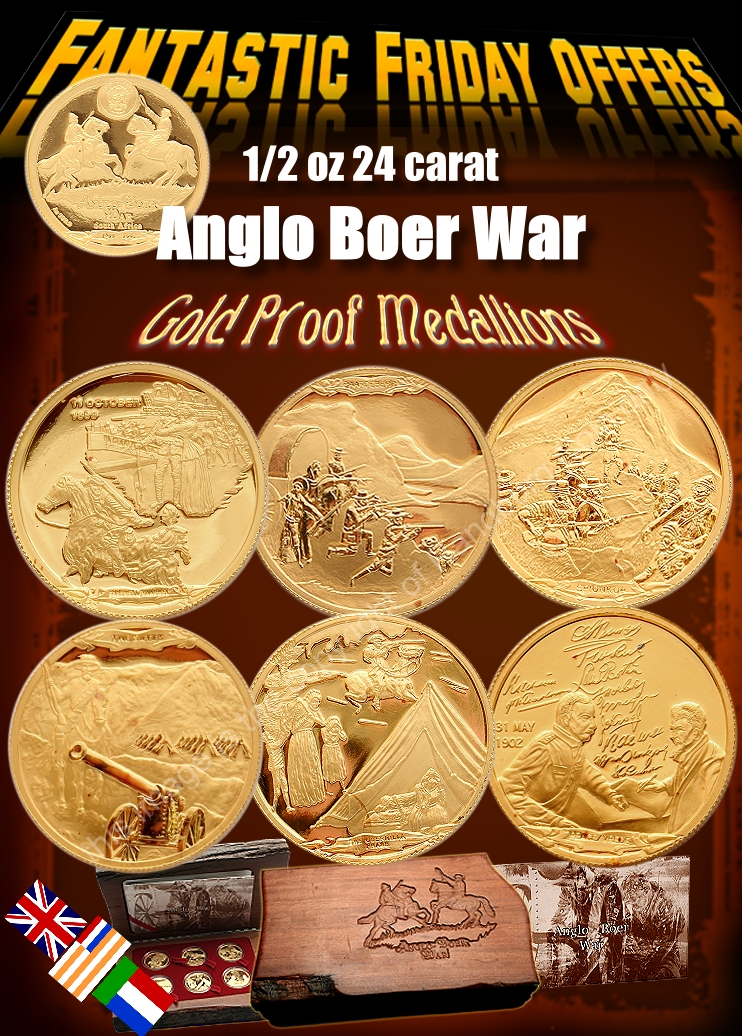Anglo Boer War Half oz 24ct Gold Proof Medallion Set
|
ref:01112017 |
THIS WEEKS FEATURED ITEM - SOUTH AFRICAN MEDALLIONS
THIS IS OUR NEW PROMOTION - A MUST HAVE - GET IT NOW
GOLD - AN ASSET CLASS
THE ANGLO-BOER WAR
PROOF GOLD MEDALLION
6 MEDALLION SET
History in your Hands
Contact us on +27 (0)11 789 2233
Limited Stock Available
MAXIMUM EDITION OF SET: 199 ONLY WORLDWIDE

Each Medallion : 24ct Gold Weight: 15.35 grams Diameter: 27.00mm
Limited Edition Worldwide of Set : 199 only
GOLD SET 24CT - OFFERED AT A VERY LOW PRICE
A TRULY MAGNIFICENT COMMEMORATIVE
SET NOW SELLING AT
WAY BELOW THE
CURRENT MARKET VALUE OF R 85 000+
GET IT NOW
AT AN ADVANTAGEOUS PRICE OPPORTUNITY FOR ONLY
R 68 500
LIMITED OFFER - NOW AVAILABLE - CALL TO CONFIRM
-------------------------------------------------------------------------------------------
The Story Told Across Six Medallions
Farewell
At the commencement of war in October 1899, the British forces garrisoned in South Africa, amounted to 20 000 men. Ultimately Britain and its main colonies of Australia, Canada and New Zealand sent 400 000 regular and volunteer contingents to fight in the war. The huge army relied on an extensive infrastructure of equipment and supplies that had to be shipped across the ocean and distributed by rail and wagon to the troops.
Paardeberg
The Western battlefront centered on Kimberley in the Northern Cape and east toward Bloemfontein, the capital of the Orange Free State Republic. The British army under Field Marshall Lord Roberts was 40 000 strong and engaged in a great flank march on Bloemfontein to bypass the Boer forces of General Piet Cronje entrenched at Magersfontein. On realising the British intentions, Cronje decided to uproot his force of 5 000 and retreat east along the Modder River to help block the British advance. Cronje's force was disabled by a large baggage train of supplies, and accompanying women and children, and decided to establish a redoubt at Paardeberg in the banks of the river to prevent being overrun by the enemy forces.
Spionkop
The reverse depicts the Battle of Spionkop at the time when the Eastern battle field centered on Ladysmith in Natal and along the border between Natal, Transvaal and the Orange Free State Republics. Ladysmith had been under seige by the Boers since the 2nd November 1899 and the British army, under the command of General Sir Redvers Buller, advancing from the south to relieve the town, met with heavy resistance from the Boers along the Tugela River. The second of these battles culminated in the Battle of Spionkop where the British were beaten for the second time. The hilly nature of the terrain was taken advantage of by the Boer Leader Louis Botha.
The Sieges
At the outbreak of the war in October 1899 the Boers besieged the three strategic towns of Kimberly, Mafeking and Ladysmith in an attempt to capture or at least preoccupy the British garrisons and thus weaken the ranks of the relatively small British force in South Africa at this time . The sieges quickly became a non-win situation that went on for several months in each case before the towns were finally relieved. The boer's most famous siege weapon was their 155mm Creusot gun, christened Long Tom, which at 10 000 yards outranged the guns of the besieged towns.
The Guerrilla Phase
After the capture of the Orange Free State and Transvaal capitals in March and May 1900 respectively , the main battle phase of the war was over and the Boer forces split into small groups to engage in guerilla activities to harass and disrupt the British occupation. The guerilla phase of the war lasted nearly twice as long as the conventional war phase.
The Peace Treaty
After two and a half years of fighting, the majority of the Boer leaders became resolved to the fact that they could not win a war against the huge resources of the British Empire, and they sought a settlement in order to rebuild their destroyed homes and reunite devastated families. The Peace Treaty of Vereeniging was signed in Melrose House, Pretoria on the 31st May 1902. For both sides it was an overdue peace, as it had become a costly war for both parties concerned.
-------------------------------------------------------------------------------------------
Botha was a charismatic leader and the principal Boer commander in the Second Boer War. He eventually made peace with the British and later became the first prime minister of the Union of South Africa .
The superior infantry tactics of the Boers helped them inflict a series of shocking defeats on the British Army in the opening stages of the Second Boer War
However, the string of victories racked up by the British Army in the latter half of the nineteenth century inspired a false confidence in its military tactics. Weaponry was evolving dramatically in this era, and the introduction of the magazine-fed bolt-action rifle dramatically increased the amount of firepower available to the infantryman of the age. While such advanced weaponry remained beyond the reach of most indigenous forces, one group was to acquire these weapons and use them to deadly effect against the British in the largest and bloodiest colonial conflict waged in the era – the Second Boer War of 1899-1902.
-------------------------------------------------------------------------------------------
TO RESERVE
Call Randburg Coin Now +27 11 789-2233 or +27 11 789 - 2234
Or email us by clicking on > This email address is being protected from spambots. You need JavaScript enabled to view it.
Offer expires - Wednesday 1st November 2017 - and/or subject to availability.
E & OE - Subject to our terms and conditions.
KINDLY NOTE:
Payment options we accept for this promotion are: Bank transfer (EFT). Or cash upon collection on these promotions.





